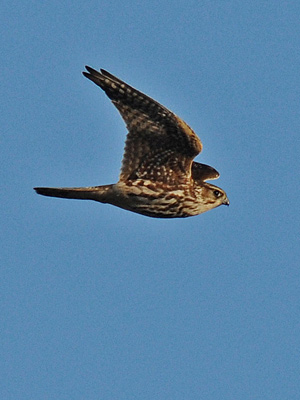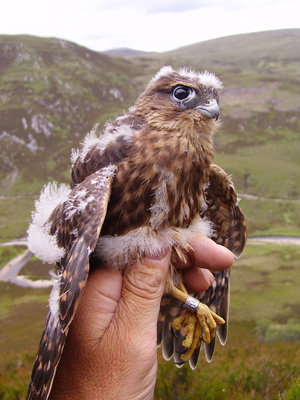
Scottish Raptor Study Group
Monitoring and conserving Scotland's birds of prey
Merlin

The merlin is the smallest falcon found breeding in the British Isles. Despite its size this species is a formidable predator particularly of other small birds. Most of its prey are caught in flight using its knowledge of the lie of the land, its speed and dashing flight. The merlin's small size and structure gives it the ability to manoeuvre very quickly when in pursuit of prey.
An upland breeder primarily restricted to heather moorland it relies heavily on open country prey. In particular, and especially during the summer months, the meadow pipit is the most frequent target. Other moorland and woodland edge species such as skylark, wheatear and chaffinch also feature in the diet at this time of year. The merlin will also regularly take moths and nestling birds.
After the breeding season around August or September the merlins, in common with their prey, tend to leave the uplands and move to lower elevations. These include both coastal and farmland localities. Most Scottish merlins winter either in Scotland or England but a few do cross over to mainland Europe and ringed birds have been recovered as far south as Spain. Coastal wintering merlins often prey on small wading birds in addition to the usual meadow pipits and other small passerine species. British merlins are joined in winter by birds from Iceland. Ringing recoveries show that these birds are generally found in western areas of Britain and in Ireland.
In the spring birds return to the uplands to breed, normally but not always returning to sites close to their natal area. Scottish merlins nest most often on the ground frequently on a slope in deep heather. Normally only a bare scrape is made and the most common clutch size is four or five eggs. In some areas they do however use old tree nests, particularly those made by carrion and hooded crows. These nests are often in small shelterbelts, occasionally in isolated trees in cleughs and sometimes on the forest edge.

Merlins are found breeding in upland areas from Shetland to the Borders. Breeding densities vary across Scotland and many apparently suitable areas lack breeding merlins. The last national survey carried out in 2008 suggested a breeding population in Britain of around 1159 breeding pairs with about 733 pairs estimated for Scotland. Comparison with the previous 1993-94 survey suggested an earlier slightly higher figure but this is not statistically significant and suggests an overall stable population. There are however some indications from local studies of a drop in breeding pairs in some areas including parts of southern Scotland.
Although merlins are generally no longer directly persecuted, their breeding habitat, much of which is on moorland primarily managed for red grouse, is vulnerable to change of land use. Over-burning of heather and blanket afforestation can impact adversely on breeding opportunities and success. The decline in farmland bird populations is also likely to have an impact on survival of wintering merlins.
Alan Heavisides
References:
Ewing, S. R., Rebecca, G.W., Heavisides, A., Court, I.R., Lindley, P., Ruddock, M., Cohen, S. and Eaton, M.A. (2011). Breeding status of Merlins Falco columbarius in the UK in 2008. Bird Study 58: 379-389.
Rebecca, G.W. (1993). The importance of the breeding population of the merlin Falco columbarius in North East Scotland. In Nicholls, M.K. and Clarke, R. (Eds.). Biology and Conservation of Small Falcons. Hawk and Owl Trust, London. Pp. 39-41.
Rebecca, G.W. and Bainbridge, I.P. (1998). The breeding status of the merlin Falco columbarius in Britain in 1993-1994. Bird Study 45: 172-187.
Rebecca, G.W. and Cosnette, B.L. (2003). Long-term monitoring of breeding merlin (Falco columbarius) in Aberdeenshire, North-east Scotland 1980-2000. In Thompson, D.B.A., Redpath, S.M., Fielding, A.H., Marquiss, M. & Galbraith, C.A. (Eds.). Birds of Prey in a Changing Environment. The Stationery Office, Edinburgh. Pp. 183-200.
Rebecca, G.W., Cosnette, B.L., Hardey, J.J.C. and Payne, A.G. (1992). Status, distribution and breeding biology of the merlin in north-east Scotland, 1980-1989. Scottish Birds 16: 165-183.
Scottish Raptors•
Honey-Buzzard•
Red Kite•
White-Tailed Eagle•
Marsh Harrier
Hen Harrier•
Goshawk•
Sparrowhawk•
Common Buzzard•
Golden Eagle
Osprey•
Kestrel•
Merlin•
Hobby•
Peregrine Falcon•
Barn Owl
Tawny Owl•
Long-eared Owl•
Short-eared Owl•
Raven